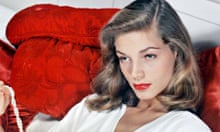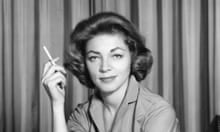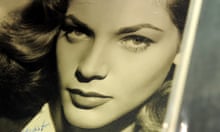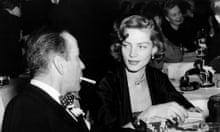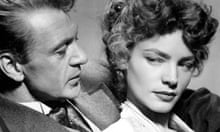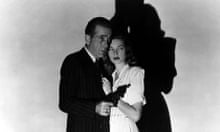Even film stars rarely get to live out a screen romance. But Lauren Bacall's husky query to Humphrey Bogart: "Anybody got a match?", at the beginning of To Have And Have Not in 1944 sparked a real-life love affair which was to end only with Bogart's death from smoking-related cancer 13 years later. The two of them defined the cigarette as sex toy, lighting each other up in all kinds of ways, circumventing the strict morals of contemporary cinema with inference as heavy as cigar fumes after a party.
In the opening credits of The Big Sleep, the camera rests on the cigarettes that Bogart's silhouette lights for them both, side by side in an ashtray, turning to ash while the off-screen couple presumably do whatever it is couples do that stops them smoking freshly-lit cigarettes before they burn down. Bacall has said that director Howard Hawks wanted a woman "to approach a scene with a man as a man would. He wanted insolence and he wanted a woman in control".
He got rather more than he wanted. In a pattern that would continue throughout Bogart and Bacall's life together, reality came to reflect the movie. Bogart's talk in films was all of his detachment ("I'm fighting nobody's battles but my own," he says in Key Largo) but it was just that -- talk. Bacall, with her sharp tongue and long-eyed look, rumbled him. By 1944, Bogart had made it as a star and as a romantic lead in Casablanca, although his image as the hardest-boiled egg in the coop was still a problem. Any actor who can convincingly turn down Ingrid Bergman for Claude Rains -- a beautiful woman for a beautiful friendship -- is going to have difficulties as a lead.
Bogart was a last-century man, born on Christmas Day 1899. As an actor his sensibility derives from the Wild West, a lawless, gunslinging world where the code of honour is no antiquated frivolity but an essential chapter in the survivor's handbook. Bergman in Casablanca is a lady in western terms: sappy, a liability under another name. As long as he played opposite women like this, Bogart would have to love 'em and lose 'em. But along came Betty Bacall, 19 years old and newly renamed Lauren, a model and aspiring actress who had been spotted in Harper's Bazaar magazine by Hawks's wife Slim.
Lauren wasn't ever going to ask her man to think for both of them, as Bergman had in Casablanca. In To Have And Have Not, her first film, she was like the bee the drunk old sailor Eddie mentions which stings even when it's dead -- especially if it died angry.
She told Bogart how to whistle, in words that a 44-year-old man was more likely to be using to a young girl than vice versa ("you just put your lips together and blow"). Bogey's Baby was a willowy blonde with slanting blue-green eyes and a habit of looking up from under them that, despite originating from nerves, was anything but coy. Of course he fell in love with her.
Anybody watching the film -- shot, unusually, in sequence -- can follow the progress of that on-screen, off-screen love, culminating in an open, tender smile Bogart never displays elsewhere on screen. Bogey always wore his toughness like an open raincoat: one of the sources of his popularity was the vulnerability visible but unacknowledged beneath. Bacall invited him in out of the storm, took that raincoat and made him comfortable.
She was the poor little Jewish girl from the Bronx who looked like a lady and he was a surgeon's son who appeared to have left his tie in a vat of whisky a while back and never bothered buying a new one. They called each other Slim and Steve after their characters in the film and they took those characters home with them.
Hawks, who was the original Steve to his wife's Slim (even in the film, these are nicknames: the sailor and his livewire girl are Harry and Marie), has claimed that Bogart fell in love with Bacall's character in the film, so she had to carry on playing it all her life. But Hawks had cast himself as Pygmalion to Bacall's Galatea (she has said that he "had a kind of Svengali approach to l'il ol' me"): he made her a star, and by all accounts was keen to make her, so it is not surprising if he tried a little damage limitation when Bogart whisked her away by implying that he was the director in their relationship as well as their film.
Still, it is undeniable that all three did some of their best work in the two films they made together. The chronology is interesting. Bogart was six years into his third marriage, to the actress Mayo Methot, when he met Bacall. The "Battling Bogarts", as they were known, kept a carpenter on call to repair the damage from their drunken fights. Alcoholic and mentally unstable, Mayo struggled to hang on to Bogey when he fell in love with Bacall on the To Have And Have Not set in 1944.
Bogart finally left Methot on the set of The Big Sleep later that year. His divorce came through on May 10, 1945 and he married his Baby on May 21. Bogart, normally so reliable, disrupted filming on The Big Sleep as he drank his way through the breakdown of his marriage and the insecurity of committing to a 20-year-old girl.
Again, art mirrored life -- or vice versa. The Big Sleep is a film noir classic based on Raymond Chandler's novel, but even Chandler was unable to unravel the film's plot once it had been knitted into a screenplay. Bogart apparently brought shooting to a halt by asking who had killed Owen Taylor, one of the film's many corpses. Nobody knew. This is no problem for the film, a wonderfully sleazy stroll through gangsterland where only the repartee flies thicker and faster than the bullets. The underlying narrative uncertainties fit perfectly with film noir, a genre that introduced shadows on to the black and white screen of early American cinema -- shadows that mirrored the murky moral landscape behind the screen.
But it must have been hell for a man whose private life was also in a shadowy state of moral confusion. Detective Philip Marlowe, Bogey's character, is very sure of himself at the start of the film, and he retains his authority throughout ("Somebody's always giving me guns," he says sarcastically at one point). But he also gets physically and morally battered, as well as falling bruisingly in love with a girl he is not sure he trusts (Bacall, of course). Marlowe gets scared -- and admits it. This is not cowboy behaviour. Bogart is not in Kansas any more -- this is the big city, where inner spaces are sinister and outer ones are plain dangerous.
What a man like Bogart always needed, in life and in his films, is a partner. Bacall was his equal in height, in toughness and in insolence -- the perfect partner. Yet she remained a girl, as opposed to the predatory women who haunt film noir, making the films and the men in them insecure and unstable. A friend of the actor once said the trouble with Bogart was that after 11pm he thought he was Bogart. But before 11pm he needed protection from the world Bogart lived in.
From the moment Bacall lights a match for Bogey's cigarette before he knows he needs a light in To Have And Have Not, we know this really is the beginning of a beautiful friendship. Bogart and Bacall made two more films together after their marriage, but something had changed. The insolence of To Have And Have Not, softened to the misguided snobbery of her character in The Big Sleep, has disappeared. Dark Passage is a muddleheaded murder mystery with Bogart as an escaped prisoner sheltered by Bacall. The film deals with loneliness and injustice (Bacall, tellingly, helps save Bogart from both), but the effect is that of a child stamping its foot and crying "it's not fair'', irritating rather than moving. Agnes Moorehead's poison-tongued bitch easily outshines both leads.
But Key Largo, directed by John Huston, is a superb film: Edward G Robinson's megalomaniac gangster imprisons Bogart's ex-soldier with the hotel owner, his daughter and a bunch of hoodlums in a Florida hotel during a hurricane. The love story here is as flimsy as the wind-whipped hotel, but once again Bacall's character falls for an authoritative action man; once again she provides roots -- she likens herself to a mangrove -- for a tired soldier old enough to be her father figure. Bacall has said that on her marriage she "immediately became part of Bogey's generation'', which may account for the change in her screen persona.
As well as the damage that turkeys like Confidential Agent caused her career, marriage undoubtedly came first to a child of divorce whose father was conspicuous by his absence: "I was married to a man who expected me to be there," Bacall has said. "He did not marry me so I could go off somewhere else."
The Bogarts presented a united front politically too. In 1947 they were among the founding members of the Committee for the First Amendment, Hollywood's retort to the activities of Joe McCarthy's House Un-American Activities Committee. The Bogarts went to Washington despite the inevitable suspicion of communist affiliation, and Bacall claims in her autobiography that it was her persuasion that put Bogey on that plane to Washington.
They appeared to have had a wonderful marriage, but Bacall had become the little woman: a devoted homebody who doesn't talk back -- who barely talks at all. In Dark Passage, she takes Bogart's escapee in. He goes out adventuring, has everything from a fight to a facelift; she is barely seen outside her comfortable, welcoming apartment.
In Key Largo she serves as a moral barometer ("When your head says one thing, your whole life says another, your head always loses," she tells Bogart, pointing up his moral duty). Sure, she gets to spit in Edward G Robinson's face, but spitting isn't talking. Despite the flying phlegm, she is ultimately passive. The evolution of Bacall's characters in her films with Bogart as well as the virtual dissolution of the rest of her career suggests one of two things: either her sparky performance in the two Hawks films was the result of great scripts baptised with young love, or Bacall fell into the career trap waiting for any young star who was more famous for her husband than for her acting talents.
The Bogarts were supposed to make another film together -- Melville Goodwin USA -- in 1956 when Bogey fell ill with the cancer of the oesophagus which was to kill him early in 1957. If marriage shut her up, children made her disappear entirely. Bogey's Baby never appeared in a film with her husband again after having a baby of her own in 1949. She made other films, but only as a sometime model determined to marry money in How To Marry A Millionaire does she stand out, while Bogey went on to win an Oscar for his boozy sailor in The African Queen.
His wife was on location with him, a homemaker in the African jungle as she was in the concrete one back home. She never regretted it. "Whenever I hear the word happy now, I think of then," she wrote in her autobiography, Lauren Bacall By Myself. In a year when the hit tune on everyone's lips was Don't Fence Me In, Bogey wrote to his fiancee, pleading "Please fence me in, Baby'' and she did. The planks she used were fashioned from her career, but it was a solid fence and both Bogarts were happy living within its parameters.
The actress Gloria Stuart, who was Oscar-nominated for Titanic, was a friend of the Bogarts. She says: "It was a lovely marriage. They supported each other personally, professionally and politically. It was gemuetlich living."
Since Bogart's death, Bacall has partially crawled out from under his shadow. An eight-year marriage to actor Jason Robards, a Tony award for the stage play Applause in 1970 and her 1996 Oscar nomination for The Mirror Has Two Faces mean that Miss Bacall can look Mrs Bogart in the eye for the first time since the latter walked in and took over.
"I like that. I'd like more," said Bacall to Bogart when they kissed in The Big Sleep. She got 12 years of bliss, but the price was steep: 40 years of being stung by a dead bee.
To Have And Have Not is re-released next Friday

